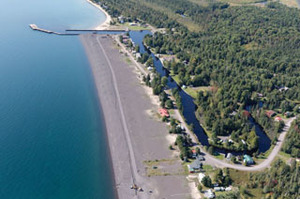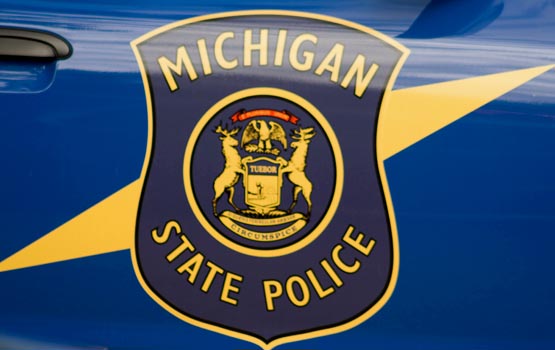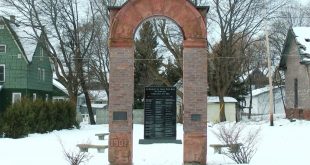 Permit and contracting issues are delaying dredging work planned for this spring and summer off the Keweenaw Peninsula that will help save Buffalo Reef from being covered by drifting stamp sands. “While the Grand Traverse Harbor will likely be dredged this fall, the project may be delayed until next year,” said Steve Casey, Upper Peninsula district supervisor for the Michigan Department of Environmental Quality’s Water Resources Division. “In the meantime, we are evaluating alternatives for long-term protection of the reef and associated juvenile fish habitat.” The dark sands are the waste material created during the milling process for the century-old copper mining at the Wolverine and Mohawk mines. The sands were dumped into Lake Superior and on the shoreline. Over the past roughly 80 years, the stamp sands have shifted south about 5 miles – moved by winds, waves and nearshore lake currents – to the Grand Traverse Harbor, covering about 1,500 acres of shoreline and lake bottom. The farther south the sands move, the more they threaten Buffalo Reef, a natural underwater structure at the bottom of Lake Superior important for lake trout and lake whitefish spawning and rearing. Last year, the Michigan Department of Natural Resources dredged 9,000 cubic yards of stamp sands out of the Grand Traverse Harbor channel to re-open the waterway for recreational and commercial boating. Previous dredging at the harbor was done by the DNR in 2015 and the U.S. Army Corps of Engineers in 2009 and 2003. However, a late October 2017 storm, which produced tremendous waves on Lake Superior, pushed stamp sands back into the harbor channel. Additional stamp sand material was blown or washed into the channel over the winter and eroded from the beaches nearby. |
 Dredging of Buffalo Reef In 2017, the EPA provided $3.1 million to the Army Corps to design and carry out dredging of the Buffalo Reef trough, a project which was scheduled to begin last month. This project is expected to provide 5 to 7 years of protection for the reef, while a long-term solution for the stamp sands problem is developed. The DNR was granted a permit from the Michigan Department of Environmental Quality, under the Great Lakes Submerged Lands Act (Part 325 of Michigan’s Natural Resources and Environmental Protection Act), to allow the Army Corps to remove these stamp sands from Lake Superior. “Concerns involving real estate and dredging natural sands versus stamp sand from an underwater trough area have resulted in changes to the proposed project,” said Steven Check, a project manager with the U.S. Army Corps of Engineers in Detroit. “These concerns have required the reworking of bid documents and potential modifications to the DNR permit, which has resulted in unexpected delays.” Check said bid specifications for the project are anticipated to go out later this month, with a contractor awarded the project in late July or early August. Dredging would then be expected to start a couple of weeks later. The trough area adjacent to the harbor may or may not be dredged late this year. Officials are in the process of scheduling a public meeting, possibly for July, to gather input on the alternatives proposed for long-term protection of the reef and to update residents and others about the ongoing effort. Meanwhile, the harbor is currently usable for recreational and commercial fishing vessels. However, it may plug up again over the summer, as river flows strong enough to flush sand from the river diminish. “The purpose of this project, based on the funding and the permit, is to protect the reef and associated juvenile fish habitat,” Casey said. “Dredging the harbor using these funds would protect the down-drift juvenile habitat, while fortuitously improving the harbor channel for boaters at the same time.” The stamp sands source pile at Gay – where the stamp mills were located – was originally estimated to contain 22 million cubic yards of material, with 2.3 million cubic yards of stamp sands remaining today. “We’re now hoping construction can start on some type of control mechanism for the original pile of stamp sands by 2022, with completion two years after that,” Casey said. “We would then hope to put a long-term solution in place by 2026. The capital and annual costs would depend on which type of long-term remedy is selected.” Efforts continue to find a beneficial use for the stamp sands removed from the beach and underwater. The Buffalo Reef Task Force has met several times over the past months, working on a wide range of issues, including an alternatives analysis, stamp sand movement projections, various cost analyses and webpage development. |
 Last year, a task force steering committee was named, which included Lori Ann Sherman, natural resources director for the Keweenaw Bay Indian Community, Tony Friona, Great Lakes liaison for the U.S. Army Corps of Engineers’ Engineer, Research and Development Center and Steve Casey, U.P. district supervisor of the DEQ’s Water Resources Division. Sherman recently accepted a job as the president of Keweenaw Bay Community College. She has been replaced on the task force steering committee by Evelyn Ravindran, who was recently promoted from managing the tribal fish hatchery to Sherman’s previous job as natural resources director for the Keweenaw Bay Indian Community. For the latest on Buffalo Reef developments sign-up for email updates and learn more at the task force’s webpage at www.michigan.gov/buffaloreef. |
 Keweenaw Report Your Source for Local News and Sports
Keweenaw Report Your Source for Local News and Sports





